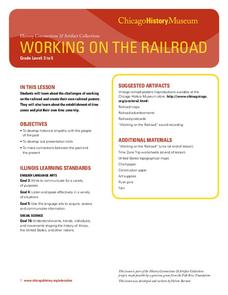Curated OER
Time Zones
Students study the reason why time zones exist and how they are established. They predict time zones for different places on Earth.
Curated OER
Time Zones
Students solve time zone problems and chart travel around the world. In this time zone lesson, students learn about the history of time zones and view a time zone map. Students use the time zone map to solve time zone problems. ...
Curated OER
Time Around the World
Seventh graders investigate the characteristics of a time zone map. They read and interpret time zone maps. Students compare the time in various time zones. Students solve time zone problems.
Curated OER
Right on Time
The hour is nigh for your class to practice equivalency problems in the form of time-zone conversions. They write equations to describe elapsed time and apply problem solving strategies, including writing a plan, to solve the problems.
Teacher's Corner
Hey Batter, Wake Up!
Does jet lag affect a baseball team's performance in games? Read about how a baseball team's chance of winning a game can be affected by traveling over one, two, and three time zones. Readers then respond to five short answer questions...
Curated OER
Time Zones in the United States
Eighth graders explore how to use the time zones in the United States and internationally. They use elapsed time to solve problems. Students calculate the time in various places in the United States. They discuss the 6 time zones in the...
Curated OER
Working on the Railroad
Learners plan a trip on the railroad. In this railroad creation and implementation lesson, students listen to the song "Working on the Railroad", make a map of where the track was laid and discuss the geographical challenges. Learners...
Curated OER
Understanding Latitude, Longitude, and Time Zones
Students take an imaginary world tour by locating cities with latitude and longitude. They plan an itinerary and calculate the time zones from which they would call home. Then they construct word problems involving travel across time zones.
Curated OER
Maps: U.S, Time Zones
Students perform various activities to demonstrate knowledge of time zones. They connect with an interactive map to discover what time zone they are in. They create clocks out of paper plates and simulate different time zones.
Curated OER
What Time Is It? (Latitude and Longitude)
Students practice latitude and longitude by identifying locations by degrees, use meanings of a.m. and p.m. appropriately, become familiar with 24-hour (universal) clock, and calculate time at different degrees longitude.
Curated OER
What Time Is It?
Fourth graders distinguish between analog and digital clocks and read time from both types. In this clock reading lesson, 4th graders discuss the types of clocks and the time zones. Students find times in specific time zones. Students...
Visa
Hall of Fame Lesson Module — Financial Football
Kick off an engaging review on personal finance with an online football game. Financial Football incorporates both football strategies and economic knowledge in an interactive format, allowing future CFOs to answer a variety of questions...
Curated OER
Globe Lesson 12: Global Time
Learners explore the concept of global time. In this geography skills lesson plan, students use standard meridians and the hour scale on globes to determine global time as they respond to questions in this self-directed lesson plan.
Curated OER
Zone Ball
Students are introduced to the basics about zone defense in basketball. In groups, they practice this technique to turn away from gravitating to the ball handler. They also complete non-bounce passes and examine how to move without a...
Space Awareness
The Climate in Numbers and Graphs
Weather versus climate: weather relates to short time periods while climate averages the weather of a period of many years. Scholars learn about average temperature and precipitation in various climate zones and then apply statistics...
Curated OER
Elapsed Time
Sixth graders investigate time, distance and speed. In this math instructional activity, 6th graders convert elapsed time into hours, minutes, and seconds. They analyze a marathon to find data on elapsed time.
Curated OER
Speedball - Lesson 3 - Drop Kick
Day 3 of the speedball unit covers the drop kick. Teach these youngsters the art of performing a drop kick with a soccer ball. Remember the ball needs to hit the ground and bounce to be a drop kick. If the ball doesn't hit the ground...
Curated OER
Striking - Toss and Hit
Help your young athletes practice hitting a ball with these fun activities. Bring in all kinds of soft bats and soft balls. Experiment with hitting balls using different size bats. Work on hand-eye coordination. Teach them the optimum...
Curated OER
Big Air Rules
Students discuss projectile motion using a basketball player taking off for a slam dunk, a fly ball launched off a hitter's bat, and a snowboarder flying off a pipe as examples. The lesson is expanded by introducing the mathematical...
Curated OER
Cirque Ignites 'Spark'
Students respond to a news article on creativity. In this reading strategy lesson, students use the SQ3R approach to evaluate what they have read. The news article is about Cirque de Soleil and creativity in everyday life.
Curated OER
Air It Out
Students practice throwing a football. In this sports lesson plan, students work in partners to complete passes until they score a touchdown. Students earn one point for each touchdown.
Curated OER
The Number System
Learners explore how to multiply and divide by 10, 100, and 1000. In this computation lesson, students participate in an online activity using the interactive whiteboard. Learners generate sums by using dice.
Curated OER
Circles in the Landscape: Irrigating Oklahoma Crops
How do you grow crops in a area with insufficient rainfall? Why you irrigate, of course. Class members investigate irrigation systems by designing a system of their own. After examining irrigation related concepts, vocabulary terms, and...
Curated OER
Island Hopping
Students collaborate to play a game. In this island hopping lesson, students face obstacles and imaginary situations in which they have to problem solve in order to complete the task.

























